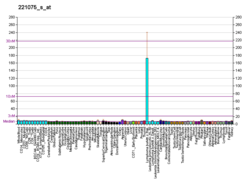Natural cytotoxicity triggering receptor 2 is a protein that in humans is encoded by the NCR2 gene .[ 3] [ 4] CD336 (cluster of differentiation 336), NKp44, NKP44; NK-p44, LY95 , and dJ149M18.1 .[ 5]
References
^ a b c GRCh38: Ensembl release 89: ENSG00000096264 – Ensembl , May 2017^ "Human PubMed Reference:" . National Center for Biotechnology Information, U.S. National Library of Medicine .^ Cantoni C, Bottino C, Vitale M, Pessino A, Augugliaro R, Malaspina A, Parolini S, Moretta L, Moretta A, Biassoni R (Jun 1999). "NKp44, a triggering receptor involved in tumor cell lysis by activated human natural killer cells, is a novel member of the immunoglobulin superfamily" . J Exp Med . 189 (5): 787– 96. doi :10.1084/jem.189.5.787 . PMC 2192947 PMID 10049942 . ^ "Entrez Gene: NCR2 natural cytotoxicity triggering receptor 2" .^ "NCR2 natural cytotoxicity triggering receptor 2 [Homo sapiens (human)] - Gene - NCBI" .
Further reading
Hershkovitz O, Jivov S, Bloushtain N, et al. (2007). "Characterization of the recognition of tumor cells by the natural cytotoxicity receptor, NKp44". Biochemistry . 46 (25): 7426– 36. doi :10.1021/bi7000455 . PMID 17536787 . Forte P, Lilienfeld BG, Baumann BC, Seebach JD (2005). "Human NK cytotoxicity against porcine cells is triggered by NKp44 and NKG2D" . J. Immunol . 175 (8): 5463– 70. doi :10.4049/jimmunol.175.8.5463 PMID 16210654 . Fuchs A, Cella M, Kondo T, Colonna M (2005). "Paradoxic inhibition of human natural interferon-producing cells by the activating receptor NKp44" . Blood . 106 (6): 2076– 82. doi :10.1182/blood-2004-12-4802 PMID 15941912 . Poggi A, Massaro AM, Negrini S, et al. (2005). "Tumor-induced apoptosis of human IL-2-activated NK cells: role of natural cytotoxicity receptors" . J. Immunol . 174 (5): 2653– 60. doi :10.4049/jimmunol.174.5.2653 PMID 15728472 . Nowbakht P, Ionescu MC, Rohner A, et al. (2005). "Ligands for natural killer cell-activating receptors are expressed upon the maturation of normal myelomonocytic cells but at low levels in acute myeloid leukemias" . Blood . 105 (9): 3615– 22. doi :10.1182/blood-2004-07-2585 PMID 15657183 . Campbell KS, Yusa S, Kikuchi-Maki A, Catina TL (2004). "NKp44 triggers NK cell activation through DAP12 association that is not influenced by a putative cytoplasmic inhibitory sequence" . J. Immunol . 172 (2): 899– 906. doi :10.4049/jimmunol.172.2.899 PMID 14707061 . Mungall AJ, Palmer SA, Sims SK, et al. (2003). "The DNA sequence and analysis of human chromosome 6" . Nature . 425 (6960): 805– 11. Bibcode :2003Natur.425..805M . doi :10.1038/nature02055 PMID 14574404 . Cantoni C, Ponassi M, Biassoni R, et al. (2004). "The three-dimensional structure of the human NK cell receptor NKp44, a triggering partner in natural cytotoxicity" . Structure . 11 (6): 725– 34. doi :10.1016/S0969-2126(03)00095-9 PMID 12791260 . Augugliaro R, Parolini S, Castriconi R, et al. (2003). "Selective cross-talk among natural cytotoxicity receptors in human natural killer cells" . Eur. J. Immunol . 33 (5): 1235– 41. doi :10.1002/eji.200323896 PMID 12731048 . S2CID 10724743 . Allcock RJ, Barrow AD, Forbes S, et al. (2003). "The human TREM gene cluster at 6p21.1 encodes both activating and inhibitory single IgV domain receptors and includes NKp44" . Eur. J. Immunol . 33 (2): 567– 77. doi :10.1002/immu.200310033 PMID 12645956 . S2CID 27147251 . Cantoni C, Ponassi M, Biassoni R, et al. (2003). "Crystallization and preliminary crystallographic characterization of the extracellular Ig-like domain of human natural killer cell activating receptor NKp44". Acta Crystallogr. D . 58 (Pt 10 Pt 2): 1843– 5. doi :10.1107/S0907444902012325 . PMID 12351833 .
External links
1–50 51–100 101–150 151–200 201–250 251–300 301–350






